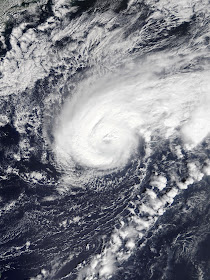20 cyclones attaining tropical depression status,
18 cyclones attaining tropical storm status,
6 cyclones attaining hurricane status, and
3 cyclones attaining major hurricane status.
Before the beginning of the season, I predicted that there would be
15 cyclones attaining tropical depression status,
14 cyclones attaining tropical storm status,
6 cyclones attaining hurricane status, and
3 cyclones attaining major hurricane status.
The average number of named storms, hurricanes, and major hurricanes for an Atlantic hurricane season (over the 30-year period 1981-2010) are 12.1, 6.4, and 2.7, respectively. The 2019 season was much above average in the number of tropical storms (in fact, it was only the sixth year since the advent of the modern naming system that the "S" name was used), but near average in the hurricane and major hurricane categories. This stemmed in part from the fact that the season featured many short-lived, weak tropical storms and a few powerful hurricanes. The ACE value for the 2019 season (which accounts for duration and intensity of storms as well as number) was around 130, just above the average. Apart from the addition of a few extra short-lived cyclones, my predictions were on target.
The El Niño event initially forecast to continue (see the first image in this post) through the 2019 summer/fall died out by July, transitioning to an ENSO neutral/slightly positive state that continued through November. Since an El Niño event typically suppresses hurricane activity, this factor alone would suggest an average to slightly below average season. Indeed, 2019 did display some of the hallmarks of an El Niño season, including storm tracks curving away from the north American mainland and wind shear in the main development region (the Caribbean and tropical western Atlantic). However, the "tropical wave train" off of Africa was quite vigorous for most of the season, and even extended later than usual into October (with Tropical Depression Fifteen among the latest forming tropical waves off of Africa ever recorded). Also offsetting the residual El Niño was the continuing ocean warmth of the subtropical Atlantic, which contributed to prolific development; nearly half of the season's storms formed in the subtropical Atlantic.
The most damaging storms of the 2019 season were Hurricane Dorian and Tropical Storm Imelda. Dorian devastated the Bahamas, especially Abacos Island and Grand Bahama, as a category 5 hurricane. It was the strongest landfalling storm on record for the region and was tied for the most intense landfalling hurricane by windspeed ever recorded in the Atlantic (with the Labor Day hurricane of 1935). Imelda was only a tropical storm, but its slow motion over southeast Texas caused a major flooding event similar to, though slightly less severe than, those associated with Harvey and Florence in the previous two years. Some other notable facts and records from the 2019 season include:
- Seven of the eighteen named storms of the 2019 season lasted less than 24 hours, a new record
- Subtropical Storm Andrea formed on May 20, marking the fifth consecutive year in which a named storm developed before the official start of the season on June 1 (also a new record)
- Dorian was the strongest Atlantic hurricane ever recorded so far north at its latitude of peak intensity, 26.6° N
- When Lorenzo became a category 5 hurricane, it marked only the seventh time on record that multiple category 5 hurricanes were recorded in a season; Lorenzo was the easternmost forming category 5 on record
- Pablo strengthened into a hurricane farther north and east than any cyclone previously observed, at 42.8° N, 18.3° W, only a few hundred miles west of the coast of Spain









































